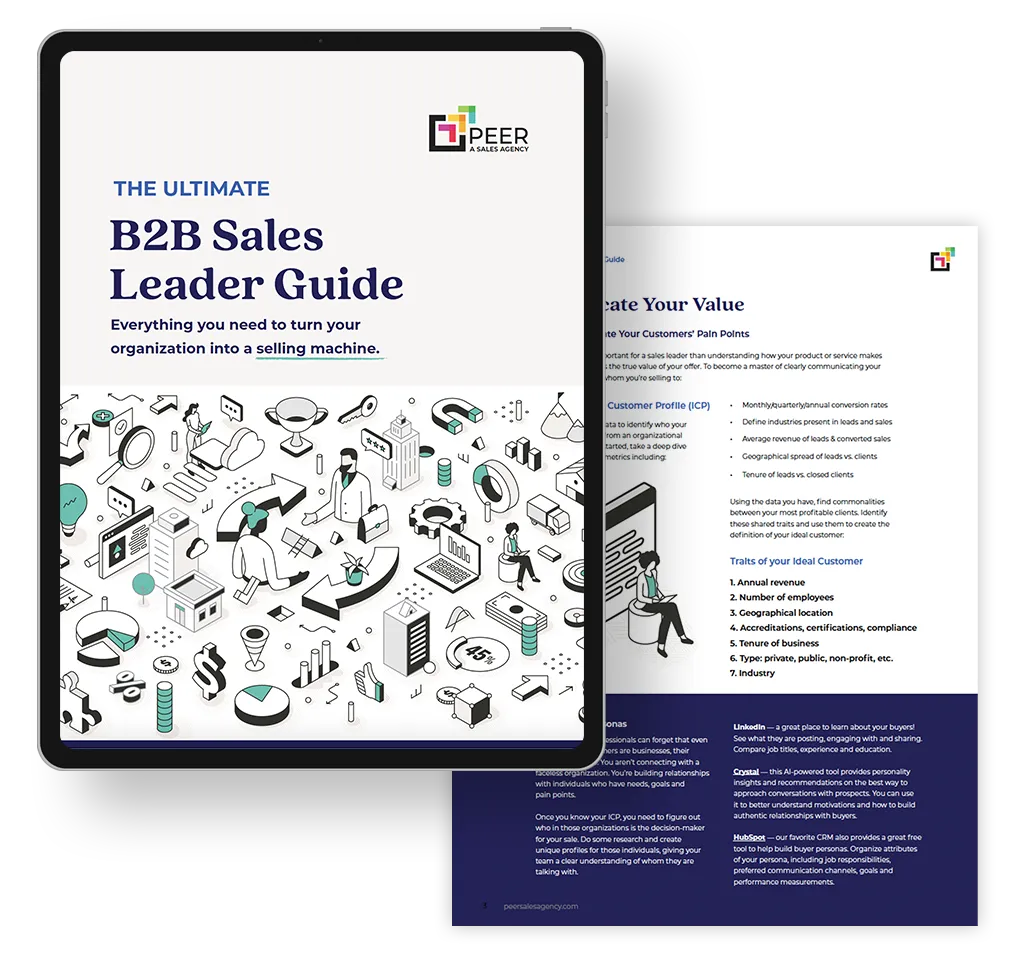Serve Your Customers With A Sales-Ready Website
As a business owner, one of your primary goals is to increase sales. Have you ever thought about the role your website plays in the buying journey potential customers go through before making a purchase? Understanding their pain points and creating an exceptional user experience can make all the difference for a lead generation website.
One of the ways Peer helps our clients is with practical advice to accelerate your conversions by making your website optimized for sales. To do this, we audit your current website, looking for ways to tweak and improve the experience to create less friction for purchase or conversion. You can see one example of this audit below:
Whether it’s improving load times or using persuasive copywriting techniques, we evaluate every aspect of your site. Let’s take a look at some proven tactics that will help you create a frictionless online experience for anyone who lands on your site.
The Grunt Test
“You want to tell your users immediately what it is you do that can help them.”
– Crystal Mackling
The Grunt Test is a concept from Donald Miller, utilized in his StoryBrand approach. The idea is to provide a quick and straightforward understanding within seconds of users landing on your page. You have only a few short moments to grab their attention before they move on, so it’s important to make those seconds count.
To pass the Grunt Test, your website needs to convey what you do and how it benefits the user. This means having a clear headline or tagline that sums up your value proposition in just a few words. It also means having engaging visuals and easy-to-read content that quickly communicates the key benefits of using your product or service.
One way to test whether your website passes the Grunt Test is by asking someone who knows nothing about your business to visit your site for five seconds and then ask them what they think you do. If they can’t answer correctly, then it’s time to go back to the drawing board.
Remember, users won’t stick around if they’re not immediately engaged with what you offer. So take some time to optimize your website for clarity and simplicity – it could be the difference between gaining new customers or losing them forever.
Engaging Visuals and Concise Copy
“Users don’t read online. They scan. You want a lot of engaging visuals and short copy.”
– Ryan Mack
When it comes to creating a sales-ready website, having scannable content and clear, concise messaging is essential. A strong messaging strategy can make or break your website’s ability to convert visitors into customers. Your messaging must communicate your unique value proposition and differentiate you from competitors. It should also be tailored to the needs of your target audience so that they feel understood and compelled to take action.
High-quality visuals are essential for any website to catch the attention of its audience. Human beings are naturally drawn to photography, imagery, and graphics. Incorporating visuals into your website can help increase engagement with your audience and ultimately lead to more sales.
When it comes to creating high-quality visuals for your website, there are a few key things to keep in mind. First and foremost is ensuring that the images you use align with your brand identity and messaging. This not only helps create a cohesive look for your site but also reinforces your brand image in the minds of potential customers.
Overall, investing time into creating high-quality visuals and concise copy is worth the effort. You can improve the user experience while also driving conversions through increased engagement levels.
Blog and Thought Leadership Strategy
“Let’s put content out there that shows you know what you’re talking about and why people can trust you.”
– Crystal Mackling
A well-executed blog strategy can help support your sales efforts in several ways.
First, a blog can be used to build relationships with potential and current customers. By providing valuable information and insights on your industry and products, you can develop trust and credibility with your readers. This can ultimately lead to more sales as customers are more likely to buy from companies they know and trust.
Second, a blog can be used to drive traffic to your website. By creating compelling content that is also optimized for search engines, you can attract new visitors to your site who may not have otherwise found you.
A blog can be used to generate leads for your sales team. By including lead magnets in your content strategy and offering free resources like e-books or whitepapers, you can encourage readers to take the next step in the buyer’s journey and contact your business about making a purchase.
Strong Calls to Action
“What do you want your user to be doing next? You have to tell them.”
– Crystal Mackling
Strong calls to action are the backbone of a successful sales-optimized website. They have the power to make or break your conversion rate. A well-placed call to action can be the difference between a visitor bouncing off your site and converting into a customer.
When designing your calls to action, it’s important to keep in mind what actions you want visitors to take on your site. Not every action is transactional. Think about “transitional” CTAs that help build ongoing relationships.
Do you want them to sign up for a newsletter? Download an eBook? Request more information?
Make sure that each call-to-action is clear, concise, and prominently placed on your website. Use strong action words like “buy,” “register,” or “subscribe” that compel users into taking immediate action.
Make sure your users can’t miss their next step. Whether through bold colors, compelling copywriting, or strategic placement around high-traffic areas of the site – strong calls to action are essential for any company looking to nurture leads online.
Social Proof and Case Studies
“You need excuses to follow up with people. Sharing some piece of content is a good excuse.”
– Ryan Mack
Social proof is the idea that people are more likely to buy from a company or product if they see that others have had success with it. This could take the form of customer testimonials, case studies, or even social media reviews.
If you’re not already using social proof on your website, now is the time to start. Here are some tips on how to include social proof and case studies on your site:
- Make sure your testimonials are from real customers. Fake testimonials will not only be ineffective, but they can also damage your credibility. If you don’t have any current customer testimonials, reach out to past customers and ask if they would be willing to provide a testimonial.
- Use case studies to show how your product or service has helped other businesses achieve their goals. Be sure to include specific details and results so that potential customers can see what you’re capable of.
- Use social media reviews and ratings to show potential customers what others think of your business. You can display these reviews on your website or link to them from your social media profiles.
Sales Team Information
“There’s a personal component to buying and selling.”
– Ryan Mack
When creating a sales-ready website, it’s important to include headshots of your sales team, as well as their bios and social profiles. This will help visitors to your site get to know your team and feel more comfortable doing business with you.
Bios should be concise and informative, highlighting each salesperson’s experience, strengths and, achievements. Social profiles should also be included so that visitors can connect with your team members on a personal level.
User-Friendly Navigation
“We’re looking for ease of navigation throughout your whole site.”
– Ryan Mack
When it comes to creating a sales-ready website, user-friendly navigation should be at the forefront of your mind. People want information quickly and easily. If they can’t find what they’re looking for on your site, they’re likely to leave and visit one of your competitors instead.
A well-designed navigation menu makes it easy for visitors to find what they need. It should be simple and intuitive, with clear labels that accurately describe each section of your site. Avoid using jargon or industry-specific terms that might confuse someone new to your business.
Another important element of user-friendly navigation is consistency. Make sure that the same menu appears on every page of your site, so visitors always know where they are and how to get back to where they started.
User-friendly navigation in building a sales-ready website not only enhances customer experience but also contributes significantly towards their engagement with the content. More time spent browsing means more chances to take the next step.
Before and After
If you’re worried your website isn’t sales optimized, we’re here to help. Ask us for a free audit and provide you with our thoughts. You can see what’s working and what isn’t, and transform your site into a high performer.
Once you get our thoughts, we’d be happy to work with you through the process of optimizing your web presence. We’ll even provide a 10% discount on your website project.
But if you’re planning to make some changes yourself, don’t forget the following tips:
- Define your target audience and create content that speaks directly to their needs and interests.
- Use keyword research to optimize your content for search engines.
- Make sure your website has a user-friendly design that makes it easy for visitors to navigate.
- Provide strong calls to action to help users know what to do next.



